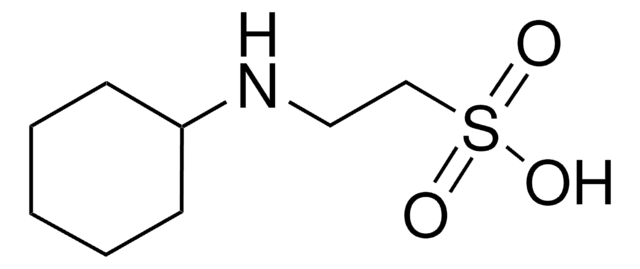P2949
PIPES sodium salt
≥99% (titration)
Sinonimo/i:
Na-PIPES, Piperazine-1,4-diethanesulfonate sodium salt, 1,4-Piperazinediethanesulfonic acid sodium salt, Piperazine-N,N′-bis(2-ethanesulfonic acid) sodium salt
About This Item
Prodotti consigliati
Saggio
≥99% (titration)
Forma fisica
crystalline powder
pH
4.5-4.7
Intervallo di pH utile
6.1-7.5
pKa (25 °C)
6.8
Solubilità
0.1 M NaOH: 250 mg/mL, clear, colorless
applicazioni
diagnostic assay manufacturing
Temperatura di conservazione
room temp
Stringa SMILE
[Na+].OS(=O)(=O)CCN1CCN(CC1)CCS([O-])(=O)=O
InChI
1S/C8H18N2O6S2.Na/c11-17(12,13)7-5-9-1-2-10(4-3-9)6-8-18(14,15)16;/h1-8H2,(H,11,12,13)(H,14,15,16);/q;+1/p-1
OGGAIRCLBMGXCZ-UHFFFAOYSA-M
Cerchi prodotti simili? Visita Guida al confronto tra prodotti
Descrizione generale
Applicazioni
- to prepare BRB80 buffer for imaging dynamic microtubules and single kinesin molecules through fluorescence microscopy
- as a component of PEM fixation solution
- to reconstitute red blood cells (RBCs) to study the effect of pH on 5-coordinate alpha-nitrosyl-hemoglobin (HbNO) stability
Caratteristiche e vantaggi
- Non-toxic
- Easy to use
- Thermally stable
- Easy to handle and store
Codice della classe di stoccaggio
11 - Combustible Solids
Classe di pericolosità dell'acqua (WGK)
WGK 3
Punto d’infiammabilità (°F)
Not applicable
Punto d’infiammabilità (°C)
Not applicable
Certificati d'analisi (COA)
Cerca il Certificati d'analisi (COA) digitando il numero di lotto/batch corrispondente. I numeri di lotto o di batch sono stampati sull'etichetta dei prodotti dopo la parola ‘Lotto’ o ‘Batch’.
Possiedi già questo prodotto?
I documenti relativi ai prodotti acquistati recentemente sono disponibili nell’Archivio dei documenti.
I clienti hanno visto anche
Il team dei nostri ricercatori vanta grande esperienza in tutte le aree della ricerca quali Life Science, scienza dei materiali, sintesi chimica, cromatografia, discipline analitiche, ecc..
Contatta l'Assistenza Tecnica.






